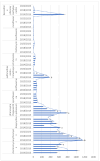Antibiotic Prescribing Trends in Dentistry during Ten Years' Period-Croatian National Study
- PMID: 39335046
- PMCID: PMC11428724
- DOI: 10.3390/antibiotics13090873
Antibiotic Prescribing Trends in Dentistry during Ten Years' Period-Croatian National Study
Abstract
Prescribing antibiotics is a regular part of daily dental practice. Antibiotics have a significant but a limited role in general dental practice due to the threat of emergence of antimicrobial resistance (AMR). As such, the aim of this study was to assess prescribing trends in dental antibiotics use from 2014-2023 in Croatia. Data on antibiotic prescribing practices for this study were provided by the Croatian Health Insurance Fund. The analysis included the number of prescriptions, packages, cost, and the World Health Organization's defined daily dose per 1000 inhabitants (DID) per day as an objective utilization for comparison. Over the 10-year period, dentists in Croatia prescribed an annual average of 357,875 antibiotic prescriptions, representing an annual average of 78.7% of all dental prescriptions. The most commonly prescribed antibiotic was the combination of amoxicillin and the beta-lactamase inhibitor clavulanic acid, which made up 58.54% of antibiotics and 46.1% of all dental prescriptions. This was followed by amoxicillin (12.61%), clindamycin (12.58%), and metronidazole (9.96%). The trend showed two discontinuations, the first for the pandemic years, and the second caused by disruption in amoxicillin production. The rise in the use of broad-spectrum antibiotics needs to be addressed and regulated to ensure patients and dentists understand that antibiotics are not a substitute for dental treatment. Dentists should always begin treatment with narrow-spectrum antibiotics regardless of possible exceptional circumstances.
Keywords: amoxicillin; antibiotics; antimicrobial resistance; odontogenic infection; prescriptions.
Conflict of interest statement
The authors declare no conflicts of interest.
Figures



References
-
- Romandini M., De Tullio I., Congedi F., Kalemaj Z., D’Ambrosio M., Laforí A., Quaranta C., Buti J., Perfetti G. Antibiotic Prophylaxis at Dental Implant Placement: Which Is the Best Protocol? A Systematic Review and Network Meta-Analysis. J. Clin. Periodontol. 2019;46:382–395. doi: 10.1111/jcpe.13080. - DOI - PubMed
Grants and funding
LinkOut - more resources
Full Text Sources
Research Materials

